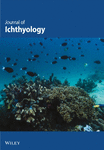Summary of mariculture production in countries neighbouring the European Union
Summary
Information on the production of cultivated fish and shellfish in marine and brackish waters in countries neighbouring the European Union has been compiled from the Food and Agriculture Organization of the UN database, Fishstat Plus. Fish production has increased rapidly in the Eastern Mediterranean and North African areas since 1989, but remains low in the Eastern Adriatic. Shellfish production in the Eastern Adriatic fell dramatically in 1991 and has not recovered. There are indications of significant increases in shellfish production in the Eastern Mediterranean since 1995.
Introduction
The other papers prepared for this volume have reviewed aspects of production, regulation and monitoring of mariculture in EU countries. The coastal seas in which these farms are located contain mariculture enterprises in non-EU countries. The mariculture industries in the EU countries compete within a market that is also supplied from non-EU European countries. It is therefore necessary, for both environmental and socio-economic reasons, to be aware of mariculture activity in countries neighbouring the EU. It is outside the scope of MARAQUA to compile reviews of mariculture for these countries in the same detail as those prepared for the EU countries. However, a brief review is presented of production levels and trends in those countries neighbouring the EU which were not represented at the first MARAQUA Workshop so that some perspective can be gained of the relative significance of production in these countries.
The information for this survey was obtained from the Food and Agriculture Organization (FAO) of the United Nations database FISHSTAT Plus. The production (metric tons) in marine and brackish water of cultivated fish and shellfish in the countries neighbouring the EU for the years 1984–97 is summarized in Tables 1–6 with the scientific names given in Appendix 1. The annual production figures in italics represent estimates made by the FAO, and those < 0.5 t are considered negligible by the FAO. A blank space refers to unknown values and a value of 0 represents no production in the relevant year.
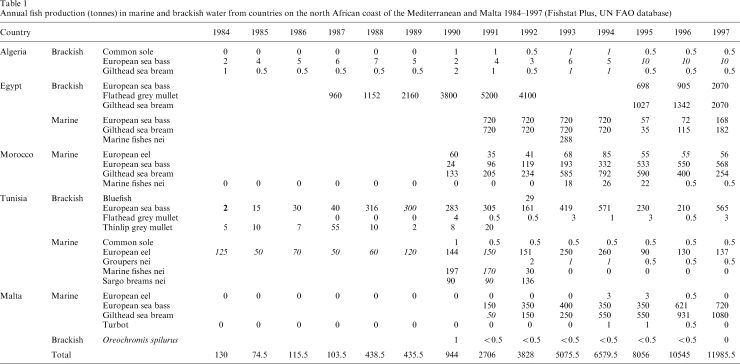





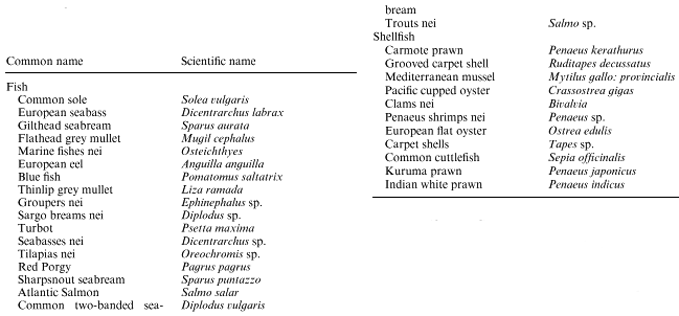
For presentational purposes (Fig. 1, fish and Fig. 2, shellfish), the countries have also been grouped geographically as described below:
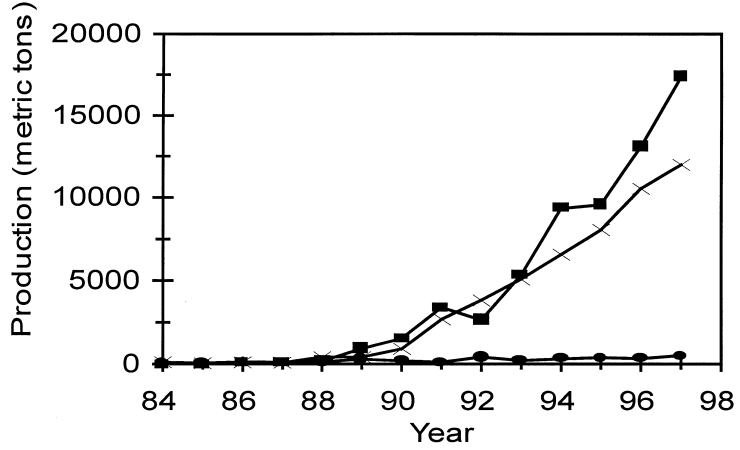
Annual production (tonnes) of fish in countries bordering the EU (1984–1997). —, North Africa and Malta (Algeria, Egypt, Malta, Morocco, Tunisia); ●, Eastern Adriatic Sea (Albania, Croatia, Slovenia, Yugoslavia SFR, Federal Republic of Yugoslavia); ▪, Eastern Mediterranean Sea (Cyprus, Israel, Turkey)
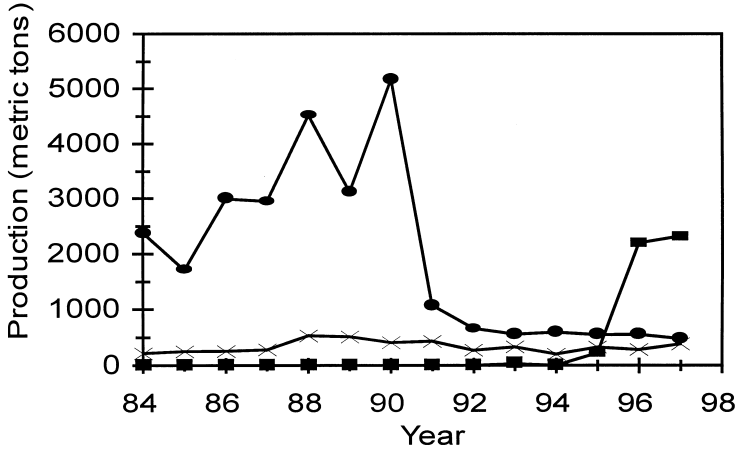
Annual production (tonnes) of shellfish in countries bordering the EU (1984–1997). —, North Africa and Malta (Algeria, Egypt, Malta, Morocco, Tunisia); ●, Eastern Adriatic Sea (Albania, Croatia, Slovenia, Yugoslavia SFR, Federal Republic of Yugoslavia); ▪, Eastern Mediterranean Sea (Cyprus, Israel, Turkey)
- 1
North Africa and Malta. Algeria, Egypt, Malta, Morroco and Tunisia have brackish water and marine aquaculture, but there is nothing recorded in the FAO database for Libya.
- 2
Eastern Mediterranean. Countries (excluding Greece) which have a coastline in the eastern Mediterranean Sea and which cultivate brackish water and/or marine species are Cyprus, Israel and Turkey. In addition Bulgaria, the Ukraine and the Russian Federation have coastlines which border the Black Sea, with production of the Mediterranean mussel of 67, 37 and 200 t, respectively, in 1997. There is also a small amount of flatfish cultivated in the Russian Federation (20 t) and mullet (150 t) in the Ukraine. Production from Bulgaria, the Ukraine and the Russian Federation are not included in the summary Figures (1 and 2) for this area. The Lebanon, Romania, Syria, and Georgia have no brackish water and/or marine aquaculture recorded in the FAO database.
- 3
Eastern Adriatic (excluding Greece). The data from 1984 to 1991 includes production values from the following countries: Croatia, Slovenia, Albania, the Yugoslavia SFR and the Federal Republic of Yugoslavia.
- 4
Southern and Eastern Baltic. There is a small volume of production from aquaculture in the Russian Federation and Poland. There are no annual production figures for brackish water fish species after 1993 in Poland. From 1984 to 1993 the annual production of fish species in brackish water in Poland ranged from 195 to 550 t. The production of sea mussels in the Russian Federation increased to 700 t in 1997. The other species cultivated in the Russian Federation is sea trout with the annual production fluctuating between 0 and 350 t. There is no brackish water or marine cultivation in Estonia, Latvia, or Lithuania. This group is therefore not included in Figs 1 and 2.
Belarus, the Czech Republic, Hungary, Moldova, Macedonia and Slovakia have no coastlines and therefore no marine or brackish water aquaculture.
Fish
The fish production for the geographical areas shows a trend towards increasing production in countries bordering the Eastern Mediterranean and along the North African Coast (including Malta). In the Eastern Mediterranean, the increased production can mainly be attributed to the cultivation of gilthead sea bream (Sparus aurata) and sea bass (Dicentrarchus sp.) in Turkey (78% of the 1997 production). There has also been increases in the production of gilthead sea bream in Cyprus and in Israel (4.4 and 3.6% of the 1997 annual production, respectively). The cultivation of three species (European sea bass, Dicentrarchus labrax; flathead grey mullet, Mugil cephalus and gilthead sea bream) in brackish water in Egypt have accounted for approximately 70% of the production in countries with North African coastlines (including Malta) in 1997. The production of these three species has increased over the 3 years for which data are available (1995–97). The marine cultivation of European sea bass and gilthead sea bream in Malta has also increased, reaching 6 and 9%, respectively, ofthe total fish production for this region in 1997. The production in the Eastern Adriatic can be mainly (73% in 1997) attributed to the marine cultivation of sea bass in Croatia (1992 onwards). There is no indication of increasing production of any of the fish species in countries with coastlines on the Eastern Adriatic Sea.
Shellfish
There was no production of shellfish in countries bordering the Eastern Mediterranean Sea prior to 1993. From 1993 to 1997, the increasing production of the Mediterranean mussel (Mytilus galloprevincialis) in Turkey has accounted for 80–98% of the total shellfish production in this area. The production of shellfish in countries with coastlines in North Africa and including Malta has varied only slightly between 1984 and 1997. The highest production in this area is the brackish-water cultivation of the Pacific cupped oyster (Crassostrea gigas) which has increased to account for 63% of the total production in 1997. The cultivation of the Mediterranean mussel in Algeria and Tunisia together account for 19% of the production in 1997. In the countries bordering the Eastern Adriatic, the decrease in production between 1990 and 1991 is due to the reduction in the brackish water cultivation of the Mediterranean mussel in Albania. From 1992 onwards, the production in this area came from the brackish water cultivation of the Mediterranean mussel in Albania and Croatia.
Authors' addresses: G. K. Rodger, Rodger Environmental, 1 Oyne Road, Aberdeen, UK. E-mail: [email protected] I. M. Davies (for correspondence), Fisheries Research Services, Marine Laboratory, Victoria Road, Aberdeen, AB11 9DB, UK. E-mail:[email protected]



